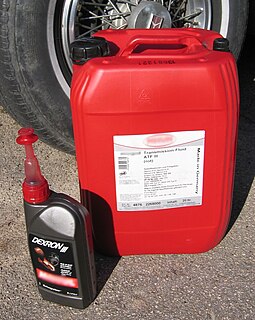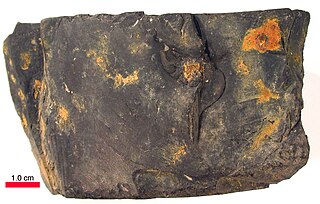 W
WAutomatic transmission fluid (ATF) is a kind of transmission fluid used in vehicles with self-shifting or automatic transmissions. It is typically coloured red or green to distinguish it from motor oil and other fluids in the vehicle.
 W
WCoal oil is a shale oil obtained from the destructive distillation of cannel coal, mineral wax, or bituminous shale, once used widely for illumination.
 W
WCutting fluid is a type of coolant and lubricant designed specifically for metalworking processes, such as machining and stamping. There are various kinds of cutting fluids, which include oils, oil-water emulsions, pastes, gels, aerosols (mists), and air or other gases. Cutting fluids are made from petroleum distillates, animal fats, plant oils, water and air, or other raw ingredients. Depending on context and on which type of cutting fluid is being considered, it may be referred to as cutting fluid, cutting oil, cutting compound, coolant, or lubricant.
 W
WDanish oil is a wood finishing oil, often made of tung oil or polymerized linseed oil, although there is no defined formulation so its composition varies among manufacturers.
 W
WA drying oil is an oil that hardens to a tough, solid film after a period of exposure to air. The oil hardens through a chemical reaction in which the components crosslink by the action of oxygen. Drying oils are a key component of oil paint and some varnishes. Some commonly used drying oils include linseed oil, tung oil, poppy seed oil, perilla oil, and walnut oil. Their use has declined over the past several decades, as they have been replaced by alkyd resins and other binders.
 W
WExpeller pressing is a mechanical method for extracting oil from raw materials. The raw materials are squeezed under high pressure in a single step. When used for the extraction of food oils, typical raw materials are nuts, seeds and algae, which are supplied to the press in a continuous feed. As the raw material is pressed, friction causes it to heat. In the case of harder nuts the material can exceed temperatures of 120 °F (49 °C).
 W
WFragrance extraction refers to the separation process of aromatic compounds from raw materials, using methods such as distillation, solvent extraction, expression, sieving, or enfleurage. The results of the extracts are either essential oils, absolutes, concretes, or butters, depending on the amount of waxes in the extracted product.
 W
WHair oil is oil applied to the hair as a cosmetic, conditioner, styling aid, restorative or tonic.
 W
WHeavy Fuel Oil (HFO) is a category of fuel oils of a tar-like consistency. Also known as bunker fuel, or residual fuel oil, HFO is the result or remnant from the distillation and cracking process of petroleum. For this reason, HFO is contaminated with several different compounds including aromatics, sulfur and nitrogen, making emission upon combustion more polluting compared to other fuel oils. HFO is predominantly used as a fuel source for marine vessel propulsion due to its relatively low cost compared to cleaner fuel sources such as distillates. The use and carriage of HFO on-board vessels presents several environmental concerns, namely the risk of oil spill and the emission of toxic compounds and particulates including black carbon. Presently, the use of HFOs is banned as a fuel source for ships travelling in the Antarctic as part of the International Maritime Organization's (IMO) International Code for Ships Operating in Polar Waters. For similar reasons, an HFO ban in Arctic waters is currently being considered.
 W
WLinseed oil, also known as flaxseed oil or flax oil, is a colourless to yellowish oil obtained from the dried, ripened seeds of the flax plant. The oil is obtained by pressing, sometimes followed by solvent extraction. Linseed oil is a drying oil, meaning it can polymerize into a solid form. Owing to its polymer-forming properties, linseed oil can be used on its own or blended with combinations of other oils, resins or solvents as an impregnator, drying oil finish or varnish in wood finishing, as a pigment binder in oil paints, as a plasticizer and hardener in putty, and in the manufacture of linoleum. Linseed oil use has declined over the past several decades with increased availability of synthetic alkyd resins—which function similarly but resist yellowing.
 W
WMERCON is the trade name for a group of technical specifications of automatic transmission fluid created by Ford. The name is a registered trademark of Ford, which licenses the name and specifications to companies which manufacture the fluid and sell it under their own brand names. Not all Mercon fluids are licensed for reselling under another brand name. All licensed Mercon fluids must have a license number on the container. If no license number is found, the fluid may not be Ford approved and the fluid cannot be guaranteed to meet Ford specifications. Ford, like many automobile manufacturers, uses transmissions sourced from other suppliers or transmission manufacturers around the world; these transmissions are not manufactured by Ford. Many of these automatic transmissions use unique fluids that might not be shown on this page.
 W
WMineral oil is any of various colorless, odorless, light mixtures of higher alkanes from a mineral source, particularly a distillate of petroleum, as distinct from usually edible vegetable oils.
 W
WThe Morris J. Berman oil spill occurred on January 7, 1994, when the Morris J. Berman, a single-hull 302-foot-long barge, with the capacity to carry more than 3 million gallons of oil, collided with a coral reef near San Juan, Puerto Rico, causing the release of 750,000 gallons of heavy grade oil. The spill affected the tourism and fishing industries as well as wildlife along the shores of Puerto Rico, Isla de Culebra, and Isla de Vieques. The spill had major long-lasting impacts on the biological and natural resources of the entire Puerto Rican area. This spill was also the first to occur in U.S. waters after the passing of the Oil Pollution Act of 1990.
 W
WOil paint is a type of slow-drying paint that consists of particles of pigment suspended in a drying oil, commonly linseed oil. The viscosity of the paint may be modified by the addition of a solvent such as turpentine or white spirit, and varnish may be added to increase the glossiness of the dried oil paint film. As we all know that the oil paints take more time as compare to other paints in drying. Many people think it is the disadvantage but this is a misconception. The time it is taking for drying is not wasting. It is focusing on providing the perfect finish to the painters. Oil paints have been used in Europe since the 12th century for simple decoration, but did not begin to be adopted as an artistic medium until the early 15th century. Common modern applications of oil paint are in finishing and protection of wood in buildings and exposed metal structures such as ships and bridges. Its hard-wearing properties and luminous colors make it desirable for both interior and exterior use on wood and metal. Due to its slow-drying properties, it has recently been used in paint-on-glass animation. Thickness of coat has considerable bearing on time required for drying: thin coats of oil paint dry relatively quickly.
 W
WPenetrating oil, also known as penetrating fluid, is very low-viscosity oil. It can be used to free rusted mechanical parts so that they can be removed, because it can penetrate into the narrow space between the threads of two parts. It can also be used as a cleaner; however, it should not be used as a general-purpose lubricant or a corrosion stopper. Using penetrating fluids as general-purpose lubricants is not advisable, because such oils are relatively volatile. As a result, much of the penetrating oil will evaporate in a short amount of time, leaving little residual lubricant.
 W
WStomach oil is the light oil composed of neutral dietary lipids found in the proventriculus (fore-gut) of birds in the order Procellariiformes. All albatrosses, procellarids and northern and austral storm petrels use the oil. The only Procellariiformes that do not are the diving petrels.